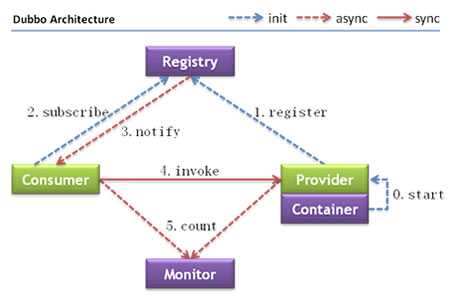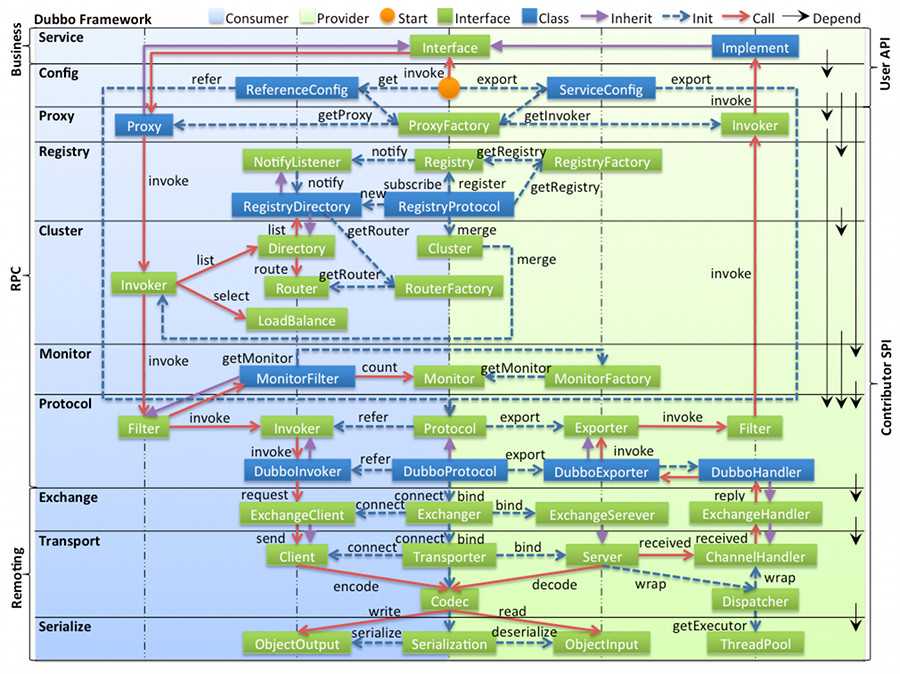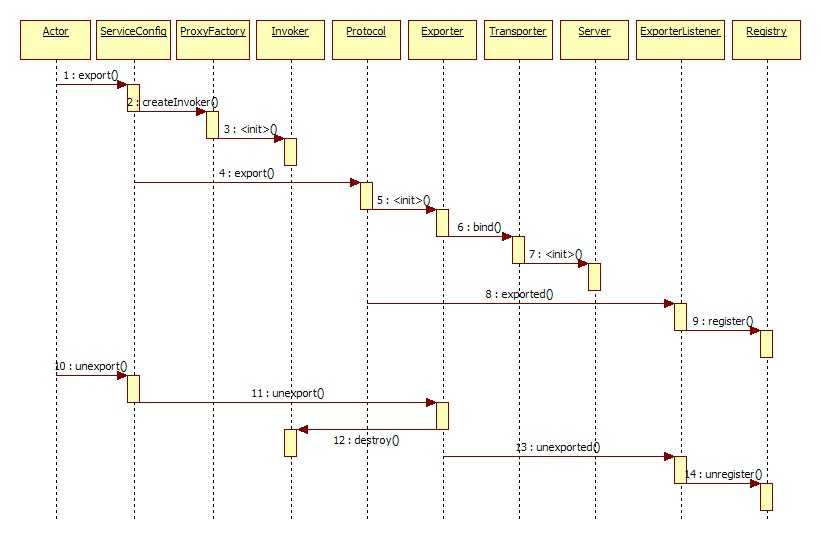标签:列表 模式 lex logs 通过 ssh 远程调用 结束 r.java
在官方《Dubbo 用户指南》架构部分,给出了服务调用的整体架构和流程:

另外,在官方《Dubbo 开发指南》框架设计部分,给出了整体设计:

以及暴露服务时序图:

本文将根据以上几张图,分析服务暴露的实现原理,并进行详细的代码跟踪与解析。
从文章《Dubbo原理和源码解析之标签解析》中我们知道,<dubbo:service> 标签会被解析成 ServiceBean。
ServiceBean 实现了 InitializingBean,在类加载完成之后会调用 afterPropertiesSet() 方法。在 afterPropertiesSet() 方法中,依次解析以下标签信息:
ServiceBean 还实现了 ApplicationListener,在 Spring 容器初始化的时候会调用 onApplicationEvent 方法。ServiceBean 重写了 onApplicationEvent 方法,实现了服务暴露的功能。
ServiceBean.java
public void onApplicationEvent(ApplicationEvent event) { if (ContextRefreshedEvent.class.getName().equals(event.getClass().getName())) { if (isDelay() && ! isExported() && ! isUnexported()) { if (logger.isInfoEnabled()) { logger.info("The service ready on spring started. service: " + getInterface()); } export(); } } }
ServiceBean 扩展了 ServiceConfig,调用 export() 方法时由 ServiceConfig 完成服务暴露的功能实现。
ServiceConfig.java
public synchronized void export() { if (provider != null) { if (export == null) { export = provider.getExport(); } if (delay == null) { delay = provider.getDelay(); } } if (export != null && ! export.booleanValue()) { return; } if (delay != null && delay > 0) { Thread thread = new Thread(new Runnable() { public void run() { try { Thread.sleep(delay); } catch (Throwable e) { } doExport(); } }); thread.setDaemon(true); thread.setName("DelayExportServiceThread"); thread.start(); } else { doExport(); } }
由上面代码可知,如果设置了 delay 参数,Dubbo 的处理方式是启动一个守护线程在 sleep 指定时间后再 doExport。
在 ServiceConfig 的 doExport() 方法中会进行参数检查和设置,包括:
ServiceConfig.java
protected synchronized void doExport() { if (unexported) { throw new IllegalStateException("Already unexported!"); } if (exported) { return; } exported = true; if (interfaceName == null || interfaceName.length() == 0) { throw new IllegalStateException("<dubbo:service interface=\"\" /> interface not allow null!"); } checkDefault(); //省略 if (ref instanceof GenericService) { interfaceClass = GenericService.class; generic = true; } else { try { interfaceClass = Class.forName(interfaceName, true, Thread.currentThread() .getContextClassLoader()); } catch (ClassNotFoundException e) { throw new IllegalStateException(e.getMessage(), e); } checkInterfaceAndMethods(interfaceClass, methods); checkRef(); generic = false; } if(local !=null){ if(local=="true"){ local=interfaceName+"Local"; } Class<?> localClass; try { localClass = ClassHelper.forNameWithThreadContextClassLoader(local); } catch (ClassNotFoundException e) { throw new IllegalStateException(e.getMessage(), e); } if(!interfaceClass.isAssignableFrom(localClass)){ throw new IllegalStateException("The local implemention class " + localClass.getName() + " not implement interface " + interfaceName); } } if(stub !=null){ if(stub=="true"){ stub=interfaceName+"Stub"; } Class<?> stubClass; try { stubClass = ClassHelper.forNameWithThreadContextClassLoader(stub); } catch (ClassNotFoundException e) { throw new IllegalStateException(e.getMessage(), e); } if(!interfaceClass.isAssignableFrom(stubClass)){ throw new IllegalStateException("The stub implemention class " + stubClass.getName() + " not implement interface " + interfaceName); } } //此处省略:检查并设置相关参数 doExportUrls(); }
在检查完参数之后,开始暴露服务。Dubbo 支持多协议和多注册中心:
ServiceConfig.java
private void doExportUrls() { List<URL> registryURLs = loadRegistries(true); for (ProtocolConfig protocolConfig : protocols) { doExportUrlsFor1Protocol(protocolConfig, registryURLs); } }
针对每个协议、每个注册中心,开始组装 URL。
ServiceConfig.java
private void doExportUrlsFor1Protocol(ProtocolConfig protocolConfig, List<URL> registryURLs) { String name = protocolConfig.getName(); if (name == null || name.length() == 0) { name = "dubbo"; } //处理host //处理port Map<String, String> map = new HashMap<String, String>(); //设置参数到map // 导出服务 String contextPath = protocolConfig.getContextpath(); if ((contextPath == null || contextPath.length() == 0) && provider != null) { contextPath = provider.getContextpath(); } URL url = new URL(name, host, port, (contextPath == null || contextPath.length() == 0 ? "" : contextPath + "/") + path, map); if (ExtensionLoader.getExtensionLoader(ConfiguratorFactory.class) .hasExtension(url.getProtocol())) { url = ExtensionLoader.getExtensionLoader(ConfiguratorFactory.class) .getExtension(url.getProtocol()).getConfigurator(url).configure(url); } //此处省略:服务暴露(详见 2.6 和 2.7) this.urls.add(url); }
如果配置 scope=none, 则不会进行服务暴露;如果没有配置 scope 或者 scope=local,则会进行本地暴露。
ServiceConfig.java
//public static final String LOCAL_PROTOCOL = "injvm"; //public static final String LOCALHOST = "127.0.0.1"; private void doExportUrlsFor1Protocol(ProtocolConfig protocolConfig, List<URL> registryURLs) { //...... String scope = url.getParameter(Constants.SCOPE_KEY); //配置为none不暴露 if (! Constants.SCOPE_NONE.toString().equalsIgnoreCase(scope)) { //配置不是remote的情况下做本地暴露 (配置为remote,则表示只暴露远程服务) if (!Constants.SCOPE_REMOTE.toString().equalsIgnoreCase(scope)) { exportLocal(url); } //...... } //...... } private void exportLocal(URL url) { if (!Constants.LOCAL_PROTOCOL.equalsIgnoreCase(url.getProtocol())) { URL local = URL.valueOf(url.toFullString()) .setProtocol(Constants.LOCAL_PROTOCOL) .setHost(NetUtils.LOCALHOST) .setPort(0); Exporter<?> exporter = protocol.export( proxyFactory.getInvoker(ref, (Class) interfaceClass, local)); exporters.add(exporter); logger.info("Export dubbo service " + interfaceClass.getName() +" to local registry"); } }
1. 暴露服务的时候,会通过代理创建 Invoker;
2. 本地暴露时使用 injvm 协议,injvm 协议是一个伪协议,它不开启端口,不能被远程调用,只在 JVM 内直接关联,但执行 Dubbo 的 Filter 链。
如果没有配置 scope 或者 scope=remote,则会进行远程暴露。
ServiceConfig.java
private void doExportUrlsFor1Protocol(ProtocolConfig protocolConfig, List<URL> registryURLs) { String scope = url.getParameter(Constants.SCOPE_KEY); //配置为none不暴露 if (! Constants.SCOPE_NONE.toString().equalsIgnoreCase(scope)) { //...... //如果配置不是local则暴露为远程服务.(配置为local,则表示只暴露远程服务) if (! Constants.SCOPE_LOCAL.toString().equalsIgnoreCase(scope) ){ if (logger.isInfoEnabled()) { logger.info("Export dubbo service " + interfaceClass.getName() + " to url " + url); } if (registryURLs != null && registryURLs.size() > 0 && url.getParameter("register", true)) { for (URL registryURL : registryURLs) { url = url.addParameterIfAbsent("dynamic", registryURL.getParameter("dynamic")); URL monitorUrl = loadMonitor(registryURL); if (monitorUrl != null) { url = url.addParameterAndEncoded(Constants.MONITOR_KEY, monitorUrl.toFullString()); } if (logger.isInfoEnabled()) { logger.info("Register dubbo service " + interfaceClass.getName() + " url " + url + " to registry " + registryURL); } Invoker<?> invoker = proxyFactory.getInvoker(ref, (Class) interfaceClass, registryURL.addParameterAndEncoded(Constants.EXPORT_KEY, url.toFullString())); Exporter<?> exporter = protocol.export(invoker); exporters.add(exporter); } } else { Invoker<?> invoker = proxyFactory.getInvoker(ref, (Class) interfaceClass, url); Exporter<?> exporter = protocol.export(invoker); exporters.add(exporter); } } } }
在服务暴露时,有两种情况:
不使用注册中心时,直接调用对应协议(如 Dubbo 协议)的 export() 暴露服务。以 Dubbo 协议为例:
DubboProtocol.java
public <T> Exporter<T> export(Invoker<T> invoker) throws RpcException { URL url = invoker.getUrl(); // export service. String key = serviceKey(url); DubboExporter<T> exporter = new DubboExporter<T>(invoker, key, exporterMap); exporterMap.put(key, exporter); //export an stub service for dispaching event Boolean isStubSupportEvent = url.getParameter(Constants.STUB_EVENT_KEY,Constants.DEFAULT_STUB_EVENT); Boolean isCallbackservice = url.getParameter(Constants.IS_CALLBACK_SERVICE, false); if (isStubSupportEvent && !isCallbackservice){ String stubServiceMethods = url.getParameter(Constants.STUB_EVENT_METHODS_KEY); if (stubServiceMethods == null || stubServiceMethods.length() == 0 ){ if (logger.isWarnEnabled()){ logger.warn(new IllegalStateException("consumer [" +url.getParameter(Constants.INTERFACE_KEY) + "], has set stubproxy support event ,but no stub methods founded.")); } } else { stubServiceMethodsMap.put(url.getServiceKey(), stubServiceMethods); } } openServer(url); return exporter; }
调用 openServer() 方法创建并启动 Server:
DubboProtocol.java
private void openServer(URL url) { // find server. String key = url.getAddress(); //client 也可以暴露一个只有server可以调用的服务。 boolean isServer = url.getParameter(Constants.IS_SERVER_KEY,true); if (isServer) { ExchangeServer server = serverMap.get(key); if (server == null) { serverMap.put(key, createServer(url)); } else { //server支持reset,配合override功能使用 server.reset(url); } } } private ExchangeServer createServer(URL url) { //默认开启server关闭时发送readonly事件 url = url.addParameterIfAbsent(Constants.CHANNEL_READONLYEVENT_SENT_KEY, Boolean.TRUE.toString()); //默认开启heartbeat url = url.addParameterIfAbsent(Constants.HEARTBEAT_KEY, String.valueOf(Constants.DEFAULT_HEARTBEAT)); String str = url.getParameter(Constants.SERVER_KEY, Constants.DEFAULT_REMOTING_SERVER); if (str != null && str.length() > 0 && ! ExtensionLoader.getExtensionLoader(Transporter.class).hasExtension(str)) throw new RpcException("Unsupported server type: " + str + ", url: " + url); url = url.addParameter(Constants.CODEC_KEY, Version.isCompatibleVersion() ? COMPATIBLE_CODEC_NAME : DubboCodec.NAME); ExchangeServer server; try { server = Exchangers.bind(url, requestHandler); } catch (RemotingException e) { throw new RpcException("Fail to start server(url: " + url + ") " + e.getMessage(), e); } str = url.getParameter(Constants.CLIENT_KEY); if (str != null && str.length() > 0) { Set<String> supportedTypes = ExtensionLoader.getExtensionLoader(Transporter.class).getSupportedExtensions(); if (!supportedTypes.contains(str)) { throw new RpcException("Unsupported client type: " + str); } } return server; }
Exchanger (默认 HeaderExchanger)封装请求响应模式,同步转异步,以 Request、Response 为中心:
HeaderExchager.java
public ExchangeServer bind(URL url, ExchangeHandler handler) throws RemotingException { return new HeaderExchangeServer(Transporters.bind(url, new DecodeHandler(new HeaderExchangeHandler(handler)))); }
Transporters.java
public static Server bind(URL url, ChannelHandler... handlers) throws RemotingException { if (url == null) { throw new IllegalArgumentException("url == null"); } if (handlers == null || handlers.length == 0) { throw new IllegalArgumentException("handlers == null"); } ChannelHandler handler; if (handlers.length == 1) { handler = handlers[0]; } else { handler = new ChannelHandlerDispatcher(handlers); } return getTransporter().bind(url, handler); }
底层传输默认使用 NettyTransporter,最终是创建 NettyServer:
NettyTransporter.java
public Server bind(URL url, ChannelHandler listener) throws RemotingException { return new NettyServer(url, listener); }
NettyServer.java
public class NettyServer extends AbstractServer implements Server { public NettyServer(URL url, ChannelHandler handler) throws RemotingException{ super(url, ChannelHandlers.wrap(handler, ExecutorUtil.setThreadName(url, SERVER_THREAD_POOL_NAME))); } }
AbstractServer.java
public abstract class AbstractServer extends AbstractEndpoint implements Server { public AbstractServer(URL url, ChannelHandler handler) throws RemotingException { super(url, handler); localAddress = getUrl().toInetSocketAddress(); String host = url.getParameter(Constants.ANYHOST_KEY, false) || NetUtils.isInvalidLocalHost(getUrl().getHost()) ? NetUtils.ANYHOST : getUrl().getHost(); bindAddress = new InetSocketAddress(host, getUrl().getPort()); this.accepts = url.getParameter(Constants.ACCEPTS_KEY, Constants.DEFAULT_ACCEPTS); this.idleTimeout = url.getParameter(Constants.IDLE_TIMEOUT_KEY, Constants.DEFAULT_IDLE_TIMEOUT); try { doOpen(); if (logger.isInfoEnabled()) { logger.info("Start " + getClass().getSimpleName() + " bind " + getBindAddress() + ", export " + getLocalAddress()); } } catch (Throwable t) { throw new RemotingException(url.toInetSocketAddress(), null, "Failed to bind " + getClass().getSimpleName() + " on " + getLocalAddress() + ", cause: " + t.getMessage(), t); } if (handler instanceof WrappedChannelHandler ){ executor = ((WrappedChannelHandler)handler).getExecutor(); } } }
NettyServer.java
public class NettyServer extends AbstractServer implements Server { protected void doOpen() throws Throwable { NettyHelper.setNettyLoggerFactory(); ExecutorService boss = Executors.newCachedThreadPool(new NamedThreadFactory("NettyServerBoss", true)); ExecutorService worker = Executors.newCachedThreadPool(new NamedThreadFactory("NettyServerWorker", true)); ChannelFactory channelFactory = new NioServerSocketChannelFactory(boss, worker, getUrl().getPositiveParameter(Constants.IO_THREADS_KEY, Constants.DEFAULT_IO_THREADS)); bootstrap = new ServerBootstrap(channelFactory); final NettyHandler nettyHandler = new NettyHandler(getUrl(), this); channels = nettyHandler.getChannels(); // final Timer timer = new HashedWheelTimer(new NamedThreadFactory("NettyIdleTimer", true)); bootstrap.setPipelineFactory(new ChannelPipelineFactory() { public ChannelPipeline getPipeline() { NettyCodecAdapter adapter = new NettyCodecAdapter(getCodec() ,getUrl(), NettyServer.this); ChannelPipeline pipeline = Channels.pipeline(); /*int idleTimeout = getIdleTimeout(); if (idleTimeout > 10000) { pipeline.addLast("timer", new IdleStateHandler(timer, idleTimeout / 1000, 0, 0)); }*/ pipeline.addLast("decoder", adapter.getDecoder()); pipeline.addLast("encoder", adapter.getEncoder()); pipeline.addLast("handler", nettyHandler); return pipeline; } }); // bind channel = bootstrap.bind(getBindAddress()); } }
如果使用了注册中心,则在通过具体协议(如 Dubbo 协议)暴露服务之后(即在 2.8 基础之上)进入服务注册流程,将服务节点注册到注册中心。
RegistryProtocol.java
public <T> Exporter<T> export(final Invoker<T> originInvoker) throws RpcException { //export invoker final ExporterChangeableWrapper<T> exporter = doLocalExport(originInvoker); //registry provider final Registry registry = getRegistry(originInvoker); final URL registedProviderUrl = getRegistedProviderUrl(originInvoker); //向Zookeeper注册节点 registry.register(registedProviderUrl); // 订阅override数据 // FIXME 提供者订阅时,会影响同一JVM即暴露服务,又引用同一服务的的场景,因为subscribed以服务名为缓存的key,导致订阅信息覆盖。 final URL overrideSubscribeUrl = getSubscribedOverrideUrl(registedProviderUrl); final OverrideListener overrideSubscribeListener = new OverrideListener(overrideSubscribeUrl); overrideListeners.put(overrideSubscribeUrl, overrideSubscribeListener); registry.subscribe(overrideSubscribeUrl, overrideSubscribeListener); //保证每次export都返回一个新的exporter实例 return new Exporter<T>() { public Invoker<T> getInvoker() { return exporter.getInvoker(); } public void unexport() { try { exporter.unexport(); } catch (Throwable t) { logger.warn(t.getMessage(), t); } try { registry.unregister(registedProviderUrl); } catch (Throwable t) { logger.warn(t.getMessage(), t); } try { overrideListeners.remove(overrideSubscribeUrl); registry.unsubscribe(overrideSubscribeUrl, overrideSubscribeListener); } catch (Throwable t) { logger.warn(t.getMessage(), t); } } }; } private Registry getRegistry(final Invoker<?> originInvoker){ URL registryUrl = originInvoker.getUrl(); if (Constants.REGISTRY_PROTOCOL.equals(registryUrl.getProtocol())) { String protocol = registryUrl.getParameter(Constants.REGISTRY_KEY, Constants.DEFAULT_DIRECTORY); registryUrl = registryUrl.setProtocol(protocol).removeParameter(Constants.REGISTRY_KEY); } return registryFactory.getRegistry(registryUrl); }
getRegistry() 方法根据注册中心类型(默认 Zookeeper)获取注册中心客户端,由注册中心客户端实例来进行真正的服务注册。
注册中心客户端将节点注册到注册中心,同时订阅对应的 override 数据,实时监听服务的属性变动实现动态配置功能。
最终返回的 Exporter 实现了 unexport() 方法,这样在服务下线时清理相关资源。
至此,服务暴露流程结束。
标签:列表 模式 lex logs 通过 ssh 远程调用 结束 r.java
原文地址:https://www.cnblogs.com/cyfonly/p/9127712.html